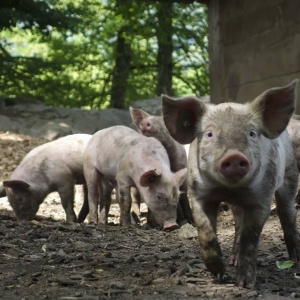
This paper, by FCRN member Hannah van Zanten (and whose authors include FCRN director Tara Garnett), calculates that a food system where livestock are fed only on food waste and industrial and agricultural by-products could provide 9 to 23 g of animal protein to the daily human diet (compared to daily protein needs of 50 to 60 g per person) while using one quarter less land than a food system with no livestock. The paper notes that the waste-fed livestock system could allow people in Asia and Africa to increase their consumption of animal protein, but that current consumption levels in other areas are higher than would be possible under a waste-fed livestock system.
For more information, read Hannah van Zanten’s blog post, “A role for livestock in a sustainable food system”, here.
Abstract
The need for more sustainable production and consumption of animal source food (ASF) is central to the achievement of the sustainable development goals: within this context, wise use of land is a core challenge and concern. A key question in feeding the future world is: how much ASF should we eat? We demonstrate that livestock raised under the circular economy concept could provide a significant, nonnegligible part (9–23 g/per capita) of our daily protein needs (~50–60 g/per capita). This livestock then would not consume human‐edible biomass, such as grains, but mainly convert leftovers from arable land and grass resources into valuable food, implying that production of livestock feed is largely decoupled from arable land. The availability of these biomass streams for livestock then determines the boundaries for livestock production and consumption. Under this concept, the competition for land for feed or food would be minimized and compared to no ASF, including some ASF in the human diet could free up about one quarter of global arable land. Our results also demonstrate that restricted growth in consumption of ASF in Africa and Asia would be feasible under these boundary conditions, while reductions in the rest of the world would be necessary to meet land use sustainability criteria. Managing this expansion and contraction of future consumption of ASF is essential for achieving sustainable nutrition security.
Reference
Van Zanten, H.H., Herrero, M., Hal, O.V., Röös, E., Muller, A., Garnett, T., Gerber, P.J., Schader, C. and De Boer, I.J., 2018. Defining a land boundary for sustainable livestock consumption. Global change biology. Early view.
Find the full paper here and the blog post here. You may be interested in the report Experts say leftovers can be safely fed to pigs and the blog post Using food waste as pig feed, both by FCRN member Karen Luyckz, and the paper Support amongst UK pig farmers and agricultural stakeholders for the use of food losses in animal feed, by FCRN member Erasmus zu Ermgassen.
See also the Foodsource chapter Focus: the difficult livestock issue, the FCRN report Lean, green, mean, obscene…? What is efficiency? And is it sustainable? and the FCRN report Gut feelings and possible tomorrows: (where) does animal farming fit?







Post a new comment »